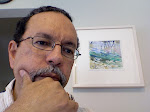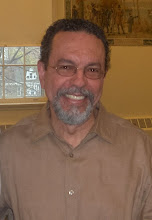I will proceed backwards. Ahora, Latin/Jazz! 2010 closed on May 14 with a salon rendering tribute to Doc Cheatham at the Emerson Auditorium at Union College in Schenectady, New York. I presented a short biographical note about Cheatham, and Ray Vega was joined by Ray Alexander on piano, Erik Johnson on bass, and Pete Sweeney on drums for a short set which included songs from Cheatham’s repertoire. Ray Vega opened the set with West End Blues to evoke the fact that during his Chicago days in the 1920s, Cheatham often subbed for Louis Armstrong at the Vendome Theater.
Not many people in the audience knew about Cheatham’s Latin connection, including the fact that he was the lead trumpet in the Ricardo Ray song Mr. Trumpet Man, from the album Jala-Jala Boogaloo Volume II. This was a particularly special salon because Cheatham’s widow, Amanda, and his daughter Alicia, were in the audience. Also, two local musicians, clarinetist Skip Parsons and drummer Tim Coakley, who had played with Cheatham, joined Ray Vega during a conversation with the audience about Cheatham’s life and music. Someone asked Mrs. Cheatham if the man that was described by Vega, Parsons, and Coakley was recognizable as the man she knew at home. Visibly amused, she replied that he was a wonderful man. Daughter Alicia confessed that she never really knew what her father did for a living until Mr. Trumpet Man came out. A child of the boogaloo era, she appreciated the song and after listening to it, she understood what her father’s work was. Before that, she said, his occupation was a mystery to her. All she knew was that he often walked out of the house carrying a small suitcase.
Two other salons preceded the tribute to Cheatham. On May 1st, Grupo Los Santos performed at the Assembly Hall at the University at Albany. Their music was introduced by a talk by Los Santos bassist David Ambrosio titled “Secrets of the Latin Bass;” so the secret is out. Previously, on April 23, Andrea Brachfeld lectured on the role of the flute in Afro Cuban music, also at the University at Albany.
The season opened with an experiment. Last year I decided that I wanted to feature a band composed of band leaders and performers in the preceding Ahora, Latin/Jazz! seasons. I shared my idea first with Chris Washburne one night at Smoke, while I was visiting New York. He thought it was a great idea and I was reassured. Before talking to him I had been doubtful. Every time I think of something, I have a tendency to play worst case scenarios in my head. My biggest fear was that, as I approached musicians individually, someone would say: “I will not play with that guy.” This obviously was not so bad as far as worst case scenarios go, but it did make me hesitate. I did not want to be privy to any bad blood or bochinche amongst musicians I admired.
I don’t remember the order in which I did it, but, after talking to Chris, I invited saxophonist Hilary Noble, co-leader of the group Enclave; drummer Willie Martínez, leader of La Familia Sextet; pianist Nicki Denner, leader of the Nicki Denner Latin jazz Trio and musical director of the all-female salsa band CocoMama; bassist Jennifer Vincent, who played for Jazz/Latino in 2008 and 2009, with Nicki Denner and Willie Martínez; and conguero Wilson “Chembo” Corniel, leader of the group Chaworó. Not only did they all agree instantly to be part of what I decided would be the Jazz/Latino All Stars, they did so respectfully and enthusiastically. I was pleased.
I wanted a front section that included trombone, sax, and trumpet. The only trumpet player I had featured previously was Brian Lynch. Brian was also enthusiastic but in the end could not make it because of a schedule conflict. So I invited Ray Vega, explaining to him that I had not called him first simply because of the concept of the band: Brian had played for Jazz/Latino in 2008 and Ray had not played the series yet. Ray’s participation turned out to be extremely felicitous.
At first, I did not give a second thought to the fact that these musicians did not play together and therefore did not have a repertoire as a working band. I kept recalling a casual exchange with trumpeter John Walsh outside S.O.B’s in New York. That night Eddie Palmieri was playing and I asked Walsh if the band ever rehearsed. His answer was that Palmieri had not had a rehearsal since the Johnson administration. “In this band is sink or swim, you have to know your stuff by heart or you’re out,” he said. I replayed this conversation over and over in my head as I thought about bringing together the All Stars.
Even though the musicians converged in Schenectady from New York, New Jersey, Boston, and Burlington, the logistics of the concert were fairly simple. I was astonished to find out that Ray Vega did not drive. Getting him to the gig was the only significant logistical challenge, which Ray met in his own astonishing way: he flew to La Guardia from Burlington and then rode to Schenectady with Chembo, who picked him up at the airport. I was frustrated by the dietary requirements of Chembo and Ray. Everybody else was fine with Indian food but these guys wanted chuletas! That’s the problem with growing up in Brooklyn or the Bronx—you forget that the border between Puerto Rico and the United States is set in Yonkers. In the end they had to settle for pizza, for crying outloud.
In retrospect, I can see that even for such high caliber musicians, the process of sharing charts by e-mail, coming together the day of the concert for the first time ever as a group, doing a quick run-through of the songs, and then playing the concert cold, must have been at least a bit worrisome. Yet, the performance was flawless. I loved it. They loved it. When you see the video you can see unmistakable signs of enjoyment—the band had a really good time! The audience was ecstatic and the feedback has been superlative. Many who missed the show have expressed their regrets to me.
A few days after the show, Willie Martínez suggested a repeat performance. I saw Chris Washburne two weeks later at Smoke and he said: “People are still talking about that concert,” meaning it was such a great experience. He confessed to having second thoughts after agreeing to play, but his worries were washed away by the outcome. When I saw Ray Vega a month later at the Cheatham tribute we talked about the concert and I shared my ambivalence about doing a sequel, worst case scenarios again playing in my head: What if the chemistry is not right the second time around? Can we avoid the curse of part II? Would a second performance obliterate the afterglow of the first? Wouldn’t it be better not to disturb a good memory? Yet, I also suggested bringing the group back together as “the Jazz/Latino All Stars Play the Music of Mongo Santamaría.” Ray liked that idea. “We have too many forgotten heroes,” he said.
So we’ll see. There’s no doubt that the 2010 season was special and a great success. The afterglow is strong. Yet, in the end, another successful season means we need to start raising another proverbial dollar. Get your wallets; 2011, here we come!
Subscribe to:
Post Comments (Atom)



No comments:
Post a Comment